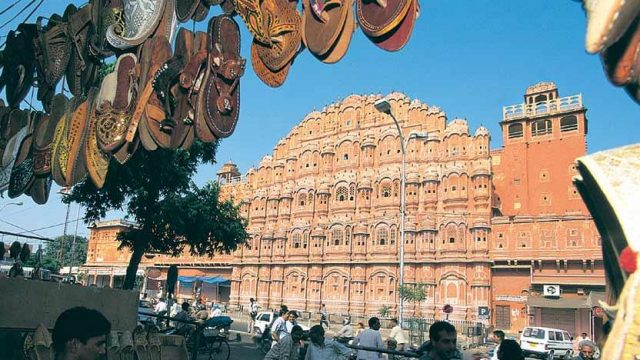A strong wind blows, stops at the closed windows in mock surprise. And then rushes inside through select orifices. It then rises up the spirals, spills over to the other side. The cylindrical balconies appear stacked upon one another, like a set of different-sized flutes tied together. Like a zampona in South America, Paixiao in China, like the flute played by Pan, the god who watches shepherds and their flocks.
From Burree Chopad, the road slopes down as it goes past the Old Legislative Assembly and Town Hall. The Palace of Winds (Hawa Mahal) in Jaipur appears on your left, a repeating pattern going over five stories, a pyramid of smaller pyramids.
Whenever I stand outside it, I’m always struck by how tall the Hawa Mahal seems in photographs, compared to its mere 50 feet! And then I see myself in old pictures, wearing the Maheshwari school uniform, less than five feet tall. I had then asked my parents why the Hawa Mahal was merely a decorated wall. Marwari businessmen show little engagement with historical trivia, and the matter was always deferred. It was annoying to see something so beautiful in the middle of a bazaar, but with no obvious purpose to it. Every matchbox-sized paan-shop in the area had taken ‘palace’ for a suffix, be it Raju, Munna or Ramsingh. As testament to them, the inner corridors of Hawa Mahal are stained with red signatures.
The 953 perforations on the facade of the Hawa Mahal serve as a breeze-making device for those who stand inside its ramping corridors. Its design is fractal — a pattern that repeats itself at every scale, like in South Indian temples. From the fourth story you can see the other side — past the sun-lit courtyard, to the tallest sundial in the Jantar Mantar of Jaipur.
When Pratap Singh built the Hawa Mahal for his harem in 1799, he had in the library European texts that were obtained by Sawai Jai Singh II, the astronomer-king who built Jaipur. Using this knowledge, the architect Lal Chand Ustad designed the Hawa Mahal on modern principles, but with Vedic inspiration. As the air blown through compressed lips is cooler than an open mouth, so is the air inside Hawa Mahal relatively pleasant. The local guides would often tell me, that this is a “naturally air-condissun”.
The Hawa Mahal served as a ‘viewing gallery’ for the raja’s women, a purdah through which they could watch processions on the street, without a threat to their modesty. Built in the shape of a crown for Lord Krishna, his many lovers gaze out of the divine godhead. The simple courtyard behind this wafer-thin façade probably doubled as the playing ground of raas-lilas.
Today, a regular gang of rhesus macaques swaggers down across the chhatris, past the copper cones, above the dynasty’s omnipresent Sun. Across, a little girl stares out of a window; an older boy closes and opens a different jharokha; they seem to be playing some kind of game. The raja’s many ladies probably once played the same mysterious game.
Many scholars feel that the Hawa Mahal, for all its splendour, is a product of royal eccentrics, a romantic ‘castle in the air’, as it were. In his book Jaipurnama, Giles Tillotson opines that “the airy name also suggests something fanciful, something insubstantial…whatever former use is claimed for it the Hawa Mahal is really a piece of whimsy”. Tillotson has written before about Lal Chand Ustad, who dedicated the design of Hawa Mahal to Lord Krishna and Radha and the orderly inspirations behind this “conceptual city” built as a Vedic mandala. Here he compares it to the Eiffel Tower, “which exists purely for its own sake, for the sheer pleasure of creation, to show that it can be done”.




